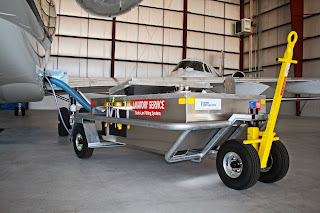How Real-Time Telematics and Tracking for GSE Can Keep Your Ground Crew Safer and Save Money
The ground support industry is a particularly complex, often stressful,
fast-moving, and extremely important industry. No one in the industry
has to be told that the stakes are huge. The airlines need their planes
fueled, checked, deiced, powered, loaded, unloaded, etc. Every extra
minute on the ground is costing them money.
Ground crew, meanwhile, need to remain safe, careful, vigilant, and be
thorough. The consequences of mistakes range from lost luggage and
furious passengers to those better not mentioned. So how does an
industry with so much at stake strike a balance between speed and
thorough safety? According to an increasing number of airports large and
small, the answer is real-time digital fleet telematics and tracking.
Telematics and Tracking
Fleet telematics and tracking is the use of a digital system to monitor and track the location, use status, maintenance status, and similar information. So a member of the ground crew could use a digital device, either on-site or remotely, to find the location of a specific aircraft tow tractor, determine whether it was running or not, be alerted to error codes and check its maintenance scheduling, and more.
While some level of fleet telematics and tracking is an increasingly common, almost ubiquitous, feature of airside work and industry, the full potential of those telematics systems is less commonly fully utilized.
Fleet telematics and tracking is the use of a digital system to monitor and track the location, use status, maintenance status, and similar information. So a member of the ground crew could use a digital device, either on-site or remotely, to find the location of a specific aircraft tow tractor, determine whether it was running or not, be alerted to error codes and check its maintenance scheduling, and more.
While some level of fleet telematics and tracking is an increasingly common, almost ubiquitous, feature of airside work and industry, the full potential of those telematics systems is less commonly fully utilized.
Wireless Checklist Scheduling and Maintenance
While nothing would get done without the ground crew, the ground support equipment (GSE) fleet is the backbone of a functioning airport. Without that GSE up and running effectively, the planes wouldn’t be going anywhere.
Fleet telematics programs can be established to link every vehicle and all equipment, like an aircraft ground power unit, to a central scheduling system that’s often located in the cloud. That provides for tracking of them but the remote links that can be attached to the vehicles can also be used to transmit information about the vehicle and its status back to members of the ground crew and supervisors.
That information can provide instant notifications about faulty equipment, including sending specific fault code notifications. Being aware of equipment issues as soon as they emerge allows for troubleshooting of the issues and resolution of problems before they become much bigger, and much more expensive, problems.
They can also forestall equipment issues by transmitting maintenance schedules for the equipment. And as the saying goes—an ounce of prevention is worth a pound of cure. Or in this case, a few dollars of prevention is worth thousands in repair.
Safer and More Cost-Effective
Knowing whether or not any of the aircraft tugs are on the fritz has benefits beyond convenience and providing an early solution to looming mechanical problems. It also helps keep ground crew safe. It’s the rare member of an airside ground crew who wouldn’t appreciate not having to guess which equipment is OK and which might malfunction in a potentially dangerous way. It can also give a hard data-based outline of which crew members are or are not checking off all of the maintenance and procedural boxes for both fleet maintenance and aircraft servicing.
The benefits go beyond the cost-effectiveness of being able to track the idling time of any GSE vehicle and remotely turn it off to save money. Simply having all of this information, planning and performing the necessary maintenance when it needs to be done, tackling problems as they emerge, and generally having GSE scheduled as efficiently as possible can save millions of dollars.
About AERO Specialties
AERO Specialties is dedicated to both quality and customer service. As part of that dedication, they ensure that all AERO Specialties’ team members, including sales and support staff, not only understand the equipment but also have an extensive, detailed understanding of aircraft handling and maintenance. AERO Specialties specializes in aircraft tugs, aircraft solutions in baggage and cargo handling, intercom systems, hydraulic fluid services, and aircraft lighting. They offer such parts as towbar and towbar head ball lock pins, shear pins, oxygen charge adapters, nitrogen service adapters, ground power unit cables, and many more parts to support your equipment fleet.
To optimize the quality and efficiency of GSE, visit AERO Specialties at Aerospecialties.com




Comments
Post a Comment